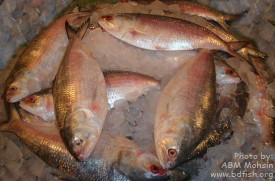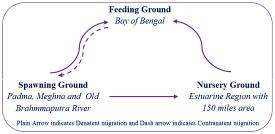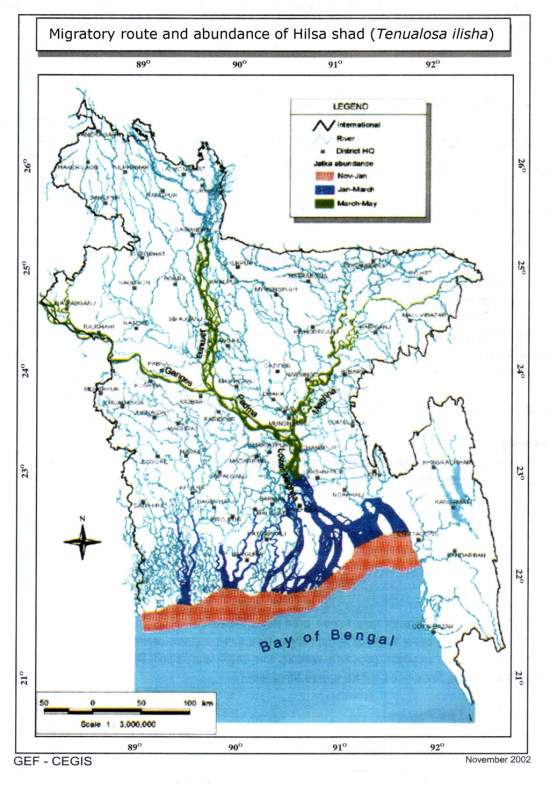
During entire life, Hilsa shad (the national fish of Bangladesh) migrates both from sea to freshwater and freshwater to sea to meet the biological demand. Hilsa shad (Tenualosa ilisha) lives in the sea for most of its life, but migrates at least 1,200-1,300 km upstream from estuarine region for spawning purpose and it also found about 250 km distance from coastal region (Halder and Islam, 2008). As this is one of the flagship fish species of Bangladesh, conservation of this species is indeed needed. Therefore, knowledge on migratory pattern and route of this species demand more attention to boost awareness and enhance conservatory practice for them in Bangladesh.
Migration:
The term migration comes from Latin word “Migrare” which means “to travel.” Generally, migration refers to any movement of animal from one place to another. On the other hand, it can be said that, migration is confined to rhythmic movement of animal which involves a journey from one place to another and come back again. “Generally, a migration is more or less continuous and direct movement from one location to another. Such movement is under the control of the fish, genetically determined, and is influenced by environmental factors. Typically, a migration includes one or more returns to the starting location” (Lagler et al., 1962).
Reasons behind migration:
Migrations are mainly for spawning or feeding purpose and are generally time oriented. Many factors influence migratory movements. They may be physical, chemical and biological (Lagler et al., 1962).
- Physical factors: bottom materials, water depth, current and tide, turbidity, temperature, and light intensity;
- Chemical factors: salinity, alkalinity, dissolved gases, odor, tastes, and pollutants and
- Biological factors: sexual development, blood pressure, social response, hunger, food, physiological clock, and endocrine state.
Migratory pattern, route and abundance of Hilsa shad:
Generally, two types of migratory pattern are seen for Hilsa shad in Bangladesh. These are-
- South-west monsoon migration: During this migration, Hilsa fish mainly lives in the sea and around the monsoon, when consequent flooding of all the rivers and it is time to spawn, swims against the tide and goes back to the river where its mother had given birth to it. Earlier, the Hilsa would move from the Bay of Bengal to Bangladesh rivers, the Padma, and the Meghna, for spawning. It would also take the western route to the Ganga. Now there is more hilsa in the west, in areas bordering Indian waters.
- Winter migration: Migration of Hilsa shad is not limited to monsoon only, but it also migrates short period during winter. It happens during the month of February to March.

Hilsa is anadromous in nature with a life cycle that follows the general pattern of breeding upstream in the freshwater and the larvae hatching from the free floating eggs. The immature young stages grow in river channels and then descend to the sea for a period of feeding and growth before returning to the rivers as mature breeding adults to complete the cycle. There are three types of grounds in Bangladesh used by the Hilsa to complete their entire life cycle or migration.
Spawning grounds:
Adult brood Hilsa mainly spawn at major deltaic rivers, estuaries and coastal areas of Bangladesh. But it has four main spawning grounds in Bangladesh (Halder and Islam, 2008). These are-
- Dhalerchar of Charfashion in Bhola (about 125 sq. km area);
- Monpura in Bhola (about 80 sq. km area);
- Moulavichar of Hatia in Noakhali (about 120 sq. km area);
- Kalirchar of Sandwip (about 194 sq. km area) of Bangladesh.
Hilsa spawn more or less throughout the year, they have a minor spawning season during February-March and a major season in September-October. Local fishermen catch migrating adults from February to May from different deltaic rivers.
Nursery grounds:
After hatching from free floating eggs, the larvae remain in their nursery grounds where they feed and grow. There are mainly five nursery grounds where Jatka (Hilsa fish sized less than 25 cm) grows for six to ten weeks before going back to the sea for further growth and maturity. These nursery grounds are situated from Shatnol of Chandpur to Char Alexander of Laxmipur (100-km stretch of Meghna River), from Madanpur / char Ilisha to char Pial of Bhola district (90 km of Shahbajpur channel of Meghna confluence), from Bheduria of Bhola to char Rustom of Patuakhali (100 km of Tentulia River), Andharmanik River route at Kalapara upazilla of Patuakhali district (40 km area) and Narhira to Bhedarganj of Shariatpur district (20 km stretch of Lower basin Padma River) (DoF, 2013). These grounds have been declared as sanctuary for conserving jatka.
Feeding and growing grounds:
Juvenile Hilsa spends about 1-1.5 years in the Bay of Bengal for further growth and development. When these fishes become sexually mature, they begin their journey to the estuary and river for spawning purpose and the cycle continues.

References:
- DoF. 2005. Ilish Shampad Sangrakhan o Unnoun Babashthapona (In Bengli) (Hilsa resource conservation and development management), Fourth fisheries project, Department of Fisheries, Ministry of Fisheries and Livestock, Dhaka, Bangladesh
- DoF. 2013. Jatka Conservation Week, Department of Fisheries, Ministry of Fisheries and Livestock, Dhaka, Bangladesh
- Halder, G. C. and Islam, M. R. 2008. Ilish Mach Sangrakhan abang Unnoun Babashthapona koushal (In Bengali) (Hilsa Fisheries Conservation, Development and Management Technique), Department of Fisheries (DoF), Dhaka, Bangladesh. pp. 1-40.
- Lagler, K. F., Bardach, J. E. and Miller, R. R. 1962. Ichthyology. John Wiley and Sons, Inc., New York. 203 p.
Visited 19,296 times, 1 visits today | Have any fisheries relevant question?
